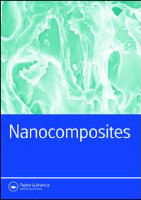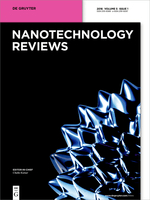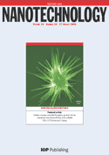
JOURNAL OF NANOPARTICLE RESEARCH
Scope & Guideline
Innovating Tomorrow's Solutions at the Nanoscale
Introduction
Aims and Scopes
- Nanoparticle Synthesis:
Research articles often explore novel methods for synthesizing nanoparticles, including green synthesis, sol-gel processes, and hydrothermal methods, emphasizing the importance of reproducibility and scalability. - Characterization Techniques:
The journal highlights various characterization techniques such as electron microscopy, X-ray diffraction, and spectroscopy to analyze the structural, optical, and electronic properties of nanoparticles. - Biomedical Applications:
A significant portion of the research focuses on the use of nanoparticles in drug delivery systems, imaging agents, and therapeutic applications, particularly in cancer treatment and antimicrobial therapies. - Environmental Applications:
Studies often investigate the application of nanoparticles in environmental remediation, including wastewater treatment, pollutant degradation, and the removal of heavy metals. - Nanocomposite Development:
Research includes the development of nanocomposites that enhance the properties of existing materials, exploring their mechanical, thermal, and electrical characteristics. - Theoretical and Computational Studies:
Many articles employ theoretical approaches and simulations (e.g., DFT) to predict and explain the properties and behaviors of nanoparticles, aiding in the design of new materials.
Trending and Emerging
- Nanoparticle-Based Drug Delivery Systems:
There is an increasing focus on the development of sophisticated drug delivery systems using nanoparticles, particularly for targeted therapy in cancer treatment and other diseases, highlighting the potential for personalized medicine. - Green Synthesis and Sustainability:
Research is trending towards environmentally friendly synthesis methods for nanoparticles, incorporating sustainable practices and materials, which aligns with the broader movement towards green chemistry. - Advanced Characterization Methods:
Emerging techniques such as in situ characterization and advanced imaging methods are gaining popularity, providing deeper insights into nanoparticle behavior at the molecular level. - Hybrid Nanomaterials and Nanocomposites:
The development of hybrid materials combining different types of nanoparticles or integrating nanoparticles into polymers is on the rise, with applications in electronics, catalysis, and energy storage. - Nanoparticles in Energy Applications:
There is a growing interest in the application of nanoparticles for energy conversion and storage, including their use in solar cells, batteries, and fuel cells. - Machine Learning and AI in Nanotechnology:
The integration of machine learning and artificial intelligence to predict nanoparticle behavior and optimize synthesis processes is an emerging trend, reflecting a broader technological advancement across scientific disciplines.
Declining or Waning
- Traditional Nanoparticle Toxicity Studies:
Earlier research focused heavily on the toxicity assessments of various nanoparticles. However, as the field matures, there is a shift towards understanding the applications and functionalities of nanoparticles rather than solely their toxicological profiles. - Basic Nanoparticle Fabrication Techniques:
Research that emphasizes basic fabrication techniques without advancements in methodology or applications has seen a decline. The focus has shifted to innovative synthesis routes and their implications. - Single-Use Nanoparticle Applications:
There is a noticeable reduction in studies focusing on single-use or low-impact applications of nanoparticles, as researchers are now more inclined to explore multifunctional or sustainable applications. - Niche Applications in Agriculture:
While the use of nanoparticles in agriculture was once a significant topic, recent publications indicate a waning interest, possibly due to regulatory challenges and a shift towards more holistic approaches in agricultural practices.
Similar Journals

FULLERENES NANOTUBES AND CARBON NANOSTRUCTURES
Advancing Nanotechnology Through Carbon InnovationFULLERENES NANOTUBES AND CARBON NANOSTRUCTURES, published by Taylor & Francis Inc, stands at the forefront of research in the fields of nanotechnology, materials science, and organic chemistry. With an ISSN of 1536-383X and an E-ISSN of 1536-4046, this journal offers a critical platform for disseminating significant findings related to carbon-based nanostructures, materials characterization, and their innovative applications. Recognized for its scholarly impact, the journal enjoys a Q2 ranking in several fields, including Atomic and Molecular Physics, Materials Science, and Organic Chemistry, reflecting its commitment to quality research. Since its inception in 2002, it has maintained a rigorous publication standard and provides open access options, enabling a diverse audience, from researchers to industry professionals, to engage with the latest advancements. The journal's comprehensive scope across converged years until 2024 emphasizes its pivotal role in fostering knowledge in the rapidly evolving realm of nanoscience and nanotechnology. Researchers and practitioners alike are encouraged to explore the cutting-edge research showcased in this vital resource.

Nanobiotechnology Reports
Unveiling innovations at the nanoscale.Nanobiotechnology Reports, an impactful journal published by PLEIADES PUBLISHING INC, serves as a prominent platform for disseminating cutting-edge research at the intersection of nanotechnology and biotechnology. With its ISSN 2635-1676 and E-ISSN 2635-1684, this open-access journal is committed to providing researchers, professionals, and students with accessible knowledge and innovations that drive advancements in this rapidly evolving field. Operating out of the United States, Nanobiotechnology Reports has established itself in various engineering and science categories, including Bioengineering and Biomedical Engineering, currently holding a Q4 quartile ranking in 2023. Although it is in the early stages of its publication journey since its convergence in 2021, the journal aims to foster collaboration and knowledge-sharing within the scientific community, addressing the complexities of nanomaterials and their applications in biological systems. Researchers and practitioners in nanobiotechnology are encouraged to contribute to this expanding body of knowledge, facilitating the development of innovative solutions that impact various sectors, from healthcare to electronics.

APPLIED PHYSICS A-MATERIALS SCIENCE & PROCESSING
Pioneering Research in Materials Science and ProcessingApplied Physics A: Materials Science & Processing, published by Springer Heidelberg, is an esteemed academic journal that has been at the forefront of innovative research since its establishment in 1995. With a strong focus on the intersection of physics, materials science, and engineering, this journal explores cutting-edge developments and applications that influence contemporary materials research. Categorized in the Q2 quartile across both Chemistry and Materials Science, it boasts respectable rankings in Scopus, affirming its influence and reach within the academic community. Although primarily a subscription-based journal, it is dedicated to disseminating high-quality research findings that advance our understanding in these fields. Researchers, professionals, and students alike can benefit from the journal's commitment to publishing comprehensive studies, methodological advancements, and insightful reviews that push the boundaries of knowledge in materials science.

Nanocomposites
Fostering Collaboration in Cutting-Edge NanomaterialsNanocomposites, published by Taylor & Francis Ltd, is a leading open-access journal dedicated to the interdisciplinary field of nanomaterials and their applications in composites. With its ISSN 2055-0324 and E-ISSN 2055-0332, the journal has established itself as a premier platform for disseminating high-quality research since its inception in 2015. It is notable for its impressive Q1 rankings across various categories, including Ceramics and Composites, Materials Chemistry, Mechanical Engineering, and Mechanics of Materials, reflecting its significant impact on the scientific community. The journal is recognized for its rigorous peer-review process and rapid publication times, making it an essential resource for researchers and professionals seeking to advance knowledge in the synthesis, characterization, and application of nanocomposite materials. With an open access policy implemented in 2017, Nanocomposites ensures that cutting-edge research is accessible to a global audience, fostering collaboration and innovation across disciplines. Emphasizing the critical role that nanocomposites play in advancing technology, this journal invites contributions that push the boundaries of current understanding and application.

Nanotechnology Reviews
Bridging Disciplines through NanotechnologyNanotechnology Reviews, published by DE GRUYTER POLAND SP Z O O, stands at the forefront of the multidisciplinary field of nanoscience and nanotechnology. With an Open Access model adopted since 2019, this journal, identifiable by its ISSN 2191-9089 and E-ISSN 2191-9097, disseminates vital research that is accessible to a global audience. The journal is located in Germany and has established itself as a premier platform for innovative research, boasting impressive quartile rankings: Q1 across several categories including Biotechnology, Energy Engineering, and Materials Science, as well as a Q2 classification in Biomaterials as of 2023. The diverse scope enables authors to contribute to a range of topics, from biomedical applications to energy solutions and advanced materials, making it essential reading for researchers, professionals, and students passionate about cutting-edge developments. Additionally, with Scopus rankings highlighting its value across various domains and robust percentiles, including 94 in Engineering (miscellaneous), 93 in Medicine (miscellaneous), and 88 in Biotechnology, Nanotechnology Reviews is an influential and respected journal that fosters scientific dialogue and innovation.

Nanofabrication
Pioneering Discoveries in Nanotechnology and BeyondNanofabrication is a leading open-access journal dedicated to advancing the field of nanotechnology through innovative research and comprehensive reviews. Published by the Eurasia Academy Publishing Group (EAPG) since 2014, this journal aims to provide a platform for academic discourse, promoting the latest insights and findings in nanofabrication techniques and applications across diverse domains, including materials science, electronics, and drug delivery systems. With a commitment to accessibility, Nanofabrication ensures that all content is freely available to researchers, professionals, and students worldwide, thereby fostering collaboration and knowledge sharing in the rapidly evolving landscape of nanotechnology. The journal's emphasis on high-quality, peer-reviewed research positions it as an authoritative source for those looking to stay at the forefront of developments in the field.

NANOTECHNOLOGY
Unleashing Potential through Nanoscience Insights.NANOTECHNOLOGY is a premier academic journal published by IOP Publishing Ltd, focusing on cutting-edge advancements in the interdisciplinary field of nanoscience and nanotechnology. With a strong emphasis on research that bridges biology, chemistry, engineering, and materials science, this journal presents high-quality, peer-reviewed articles that cater to the diverse interests of researchers, professionals, and students alike. NANOTECHNOLOGY boasts an impressive ISSN: 0957-4484 and E-ISSN: 1361-6528, and holds a notable position within Scopus, ranked in the second quartile (Q2) across multiple categories including Bioengineering and Mechanical Engineering, underscoring its vital role in advancing the field. The journal's impact is further highlighted by its robust rankings, making it essential reading for those looking to stay at the forefront of nanotechnology research. Commencing in 1990 and with publication extending through to 2024, NANOTECHNOLOGY provides a unique platform for disseminating significant findings and innovative methodologies while fostering collaborations across various scientific disciplines. In a rapidly evolving technological landscape, this journal not only enhances academic discourse but also contributes to the practical applications of nanotechnology in real-world scenarios.

Journal of Experimental Nanoscience
Elevating Knowledge in Nanotechnology and Materials ScienceThe Journal of Experimental Nanoscience, published by Taylor & Francis Ltd, is an esteemed open-access journal dedicated to advancing the field of nanoscience and its applications across various disciplines. Since its establishment, the journal has aimed to provide a comprehensive platform for researchers and professionals to disseminate innovative findings in nanotechnology, bioengineering, and materials science. With an ISSN of 1745-8080 and E-ISSN of 1745-8099, this journal has been pivotal in promoting high-quality research in its converged years from 2006 to 2024. Recognized for its contributions, it currently holds a Q3 ranking in core categories such as Bioengineering, Biomedical Engineering, Materials Science, and Nanoscience and Nanotechnology. Although its H-index is not specified, its Scopus ranks reflect its growing influence, with notable percentiles in various engineering fields. By offering open access since 2016, the Journal of Experimental Nanoscience enhances the accessibility of vital research to a global audience. Researchers, professionals, and students will find this journal an invaluable resource for staying abreast of the latest advancements and breakthroughs in nanoscience.

BIOINORGANIC CHEMISTRY AND APPLICATIONS
Advancing the frontiers of bioinorganic chemistry.BIOINORGANIC CHEMISTRY AND APPLICATIONS, published by HINDAWI LTD, is a distinguished journal dedicated to advancing the field of bioinorganic chemistry, offering an open access platform since 2008. With an ISSN of 1565-3633 and E-ISSN of 1687-479X, this journal provides a global forum for researchers, practitioners, and scholars in the vibrant fields of Biochemistry, Inorganic Chemistry, and Organic Chemistry. Recognized for its scholarly impact, it holds an impressive Q2 rank in Biochemistry and Q1 ranks in both Inorganic and Organic Chemistry in the 2023 metrics. Catering to a diverse audience, the journal emphasizes the importance of interdisciplinary research and the application of inorganic chemistry in biological systems. With an accessible range of articles aimed at fostering scientific dialogue and innovation, BIOINORGANIC CHEMISTRY AND APPLICATIONS plays a crucial role in shaping future research and application in the chemical sciences.

New Materials Compounds and Applications
Fostering Collaboration in the World of Materials ScienceNew Materials Compounds and Applications is a pioneering journal published by JOMARD PUBLISHING, focusing on the latest advancements in materials science, particularly in the realms of analytical, inorganic, and organic chemistry. Since its inception in 2019, this journal has quickly established itself as a valuable resource for researchers and professionals seeking to explore innovative compounds and their applications across various fields. With an ISSN of 2521-7194 and an E-ISSN of 2523-4773, New Materials Compounds and Applications is indexed in Scopus, demonstrating its scholarly impact, albeit currently positioned in the Q3 and Q4 quartiles for several chemistry categories. The journal serves as a platform for disseminating research findings and fostering collaboration among scientists in Azerbaijan and beyond. Although it operates under a traditional access model, the journal aims to bridge the gap between theoretical studies and practical applications, making it essential reading for students and professionals looking to stay updated in the dynamic landscape of materials chemistry.